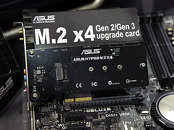- Joined
- Oct 9, 2007
- Messages
- 47,878 (7.38/day)
- Location
- Dublin, Ireland
| System Name | RBMK-1000 |
|---|---|
| Processor | AMD Ryzen 7 5700G |
| Motherboard | Gigabyte B550 AORUS Elite V2 |
| Cooling | DeepCool Gammax L240 V2 |
| Memory | 2x 16GB DDR4-3200 |
| Video Card(s) | Galax RTX 4070 Ti EX |
| Storage | Samsung 990 1TB |
| Display(s) | BenQ 1440p 60 Hz 27-inch |
| Case | Corsair Carbide 100R |
| Audio Device(s) | ASUS SupremeFX S1220A |
| Power Supply | Cooler Master MWE Gold 650W |
| Mouse | ASUS ROG Strix Impact |
| Keyboard | Gamdias Hermes E2 |
| Software | Windows 11 Pro |
For all those without M.2 slots on their motherboards, and want to buy some of the new-generation SSDs that offer transfer rates as high as 1.8 GB/s, ASUS unveiled a cost-effective new way, with its ASUS Hyper M.2 X4 adapter. It's a simple half-height add-on card, which converts PCI-Express 2.0/3.0 x4 to M.2, with gen 2.0/3.0 x4 wiring, so not only can you install current-generation M.2 SSDs with PCIe 2.0 x2 link layer, but also certain upcoming ones based on SandForce 3700 series processors, that feature PCIe 2.0 x4 link layer, offering stellar 1.8 GB/s sequential transfers. The card is also future-proof against an M.2 standard that makes use of PCI-Express gen 3.0. In addition to the M.2 slot, which can seat drives as long as 12 cm, the card also features some basic electrical circuitry, and M.2 SSD link/activity LEDs. For use on older (pre-M.2 motherboards), you may need BIOS support and/or F6 drivers from the SSD manufacturer, this card is merely an adapter, of the kind Plextor bundles with its M6e SSDs.

View at TechPowerUp Main Site

View at TechPowerUp Main Site








